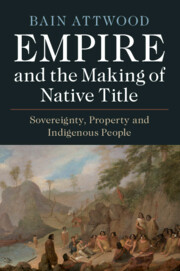Book contents
- Empire and the Making of Native Title
- Empire and the Making of Native Title
- Copyright page
- Dedication
- Contents
- Acknowledgements
- Abbreviations
- Principal Players
- Maps
- Introduction
- 1 Claiming Possession in New Holland and New Zealand, 1770s–1820s
- 2 Batman’s Treaty and the Rise and Fall of Native Title, 1835–1836
- 3 The South Australian Colonisation Commission, the Colonial Office and Aboriginal Rights in Land, 1834–1837
- 4 Protection Claims and Sovereignty in the Islands of New Zealand, 1800–1839
- 5 Making Agreements and a Struggle for Authority, 1839–1840
- 6 The Land Claims Commission and the Return of the Treaty, 1840–1843
- 7 A Colony in Crisis and a Select Committee, 1843–1844
- 8 The Retreat of the Government and the Rise of the Treaty, 1844–1845
- 9 The Making of Native Title, 1845–1850
- Conclusion
- Appendix: The English Text of the Treaty of Waitangi
- Bibliography
- Index
9 - The Making of Native Title, 1845–1850
Published online by Cambridge University Press: 03 July 2020
- Empire and the Making of Native Title
- Empire and the Making of Native Title
- Copyright page
- Dedication
- Contents
- Acknowledgements
- Abbreviations
- Principal Players
- Maps
- Introduction
- 1 Claiming Possession in New Holland and New Zealand, 1770s–1820s
- 2 Batman’s Treaty and the Rise and Fall of Native Title, 1835–1836
- 3 The South Australian Colonisation Commission, the Colonial Office and Aboriginal Rights in Land, 1834–1837
- 4 Protection Claims and Sovereignty in the Islands of New Zealand, 1800–1839
- 5 Making Agreements and a Struggle for Authority, 1839–1840
- 6 The Land Claims Commission and the Return of the Treaty, 1840–1843
- 7 A Colony in Crisis and a Select Committee, 1843–1844
- 8 The Retreat of the Government and the Rise of the Treaty, 1844–1845
- 9 The Making of Native Title, 1845–1850
- Conclusion
- Appendix: The English Text of the Treaty of Waitangi
- Bibliography
- Index
Summary
While the appointment of Howick, now Earl Grey, to the position of Colonial Secretary in 1846 promised the triumph of the New Zealand Company’s campaign to undo the consequences of the imperial and government’s recognition of native title over much of the colony’s lands, this did not come to pass. In both New Zealand and London, leading figures were troubled that the principles Earl Grey championed in regard to native title would mean that the government would break the promises they claimed the British Crown had entered into with the natives in making the Treaty of Waitangi, and they brought pressure to bear on the government. But, most importantly, for all the talk about the importance of defining the nature of native rights of property, philosophical ideas and legal principles counted for very little in the way that native title was finally treated by the British government. A new governor, George Grey, had been provided the resources denied to his predecessors, and he purchased large swathes of land from the natives. In doing so, native title was made, once and for all, in New Zealand.
- Type
- Chapter
- Information
- Empire and the Making of Native TitleSovereignty, Property and Indigenous People, pp. 340 - 400Publisher: Cambridge University PressPrint publication year: 2020



